Quality Hand-Fed Avian Companions
The Heat is On – Keeping Birds Warm
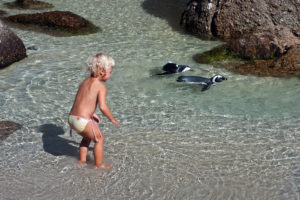
DISCLAIMER: We are not affiliated with or sponsored by any of the brands mentioned in this article. However, a small percent of purchases made through Amazon affiliate links goes back to help support our birds.
Most people think of parrots as being tropical animals, and that’s generally true. But that doesn’t mean they always need to have tropical temperatures. But what about keeping birds in places that aren’t a tropical rainforest?
Like most animals, they are able to adapt to a variety of climates as the seasons change. Even penguins, known for cold climates, can live in places like South African. The key is to avoid sudden drastic changes that don’t give them time for their bodies to adjust. So how do we go about making sure your birds are warm enough even if the weather isn’t? Read on!
Babies
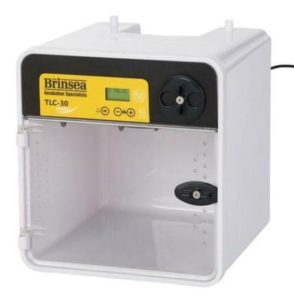 With baby birds that aren’t fully feathered yet, it’s especially important to keep them warm since they don’t have their own insulation. If there’s more than one, baby birds of all species will naturally huddle together and share body heat. But if the parents aren’t caring for them and they need to be pulled from the nest box, babies are placed in a brooder. There is a wide variety of types and brands, small and large, but all brooders are basically a heated box designed to automatically maintain a specific temperature. Some models also control humidity level. For most of the species we raise, we’ve learned that the ideal setting is in the high 90s.
With baby birds that aren’t fully feathered yet, it’s especially important to keep them warm since they don’t have their own insulation. If there’s more than one, baby birds of all species will naturally huddle together and share body heat. But if the parents aren’t caring for them and they need to be pulled from the nest box, babies are placed in a brooder. There is a wide variety of types and brands, small and large, but all brooders are basically a heated box designed to automatically maintain a specific temperature. Some models also control humidity level. For most of the species we raise, we’ve learned that the ideal setting is in the high 90s.
Maintaining temperature is especially important when traveling with babies. We have a few portable brooders that plug into the cigarette adapter in the car. If you don’t raise babies often, it may not be practical to invest in an expensive professional brooder. In a pinch, we’ve been able to use electric heating pads with glass aquariums or even plastic bins. This will work, but you’ll have to check on them much more often.It’s just a lot harder to control and hold a specific temperature this way, since there’s it’s not regulated. Here’s a handy DIY guide for making your own basic one. Regardless of what type of brooder you’re using for your babies, its always a good idea to include a small damp rag or paper towel inside to maintain moisture in the air and prevent their delicate skin the from getting too dried out.
Once their feathers are starting to come in and they are more active, our babies graduate to their own containers. We use Rubbermaid plastic storage bins with a layer of compressed wood pellets in the bottom for bedding. The best way we’ve found to provide warmth is to simply put half of the bin on top of an inexpensive heating pad. This allows the birds to control their own temperature depending on where they choose to hang out. If they get too warm, they can simply move to the cooler side.
Indoor Birds
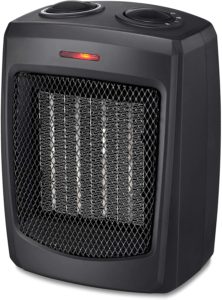 If you’re comfortable, your indoor birds probably are too. If your house is kept cooler in winter, you may want to provide a small space heater in your bird room. A small ceramic space heater or coil heaters are good options, but make sure that the temperature controls work properly and you can maintain a consistent level. The simpler models only have options for low, medium, and high instead of explicitly setting a temperature. If you don’t keep a separate thermometer in the room to keep tabs on it, it’s easy to overheat a small space. Any heater you choose should have a tip-switch that automatically cuts power if it gets knocked over.
If you’re comfortable, your indoor birds probably are too. If your house is kept cooler in winter, you may want to provide a small space heater in your bird room. A small ceramic space heater or coil heaters are good options, but make sure that the temperature controls work properly and you can maintain a consistent level. The simpler models only have options for low, medium, and high instead of explicitly setting a temperature. If you don’t keep a separate thermometer in the room to keep tabs on it, it’s easy to overheat a small space. Any heater you choose should have a tip-switch that automatically cuts power if it gets knocked over.
Never use fuel-based heaters! Kerosene is common for heating, but puts off fumes that can be toxic for birds, and in some cases even emit carbon monoxide. That’s a bad idea for birds AND people! If you have a fireplace or wood burning stove, make sure it’s properly vented and you have good airflow through the room. Another thing to avoid with heaters is anything with teflon (PTFE). It’s not usually an issue for humans unless it burns, but birds are much more sensitive.
You should also be careful about power cords around any kind of animal, but especially birds. Inspect them on a regular basis to make sure no one has been nibbling! Our birds seem to particularly enjoy the flavor of our internet cables.
Outdoor Birds
For adult birds being kept outdoors, ensuring they have a dry place protected from wind and the elements is crucial. Cold air is one thing, but if it’s cold AND wet, that’s another issue all together. Moisture in the air can chill a bird faster than dry air will even if the temperature is lower. Metal nest boxes should be insulated, and wooden perches checked regularly. Birds can survive surprisingly low temperatures for shorter periods, but if the surface they are standing on gets too cold, they could lose toes to frostbite. Some birds will abandon their perches to sit at the bottom of the cage closer to the heat lamps, so make sure that they aren’t enticed to sit on the cold metal of the cage.
When our aviary was based in Louisiana, cold was only an issue for a small part of the year, but humidity was constant. Our outdoor birds would adapt to the seasonal fluctuations, and during colder months we would weather wrap the entire aviary in plastic sheeting to trap in heat like a greenhouse. The structure was built like a partially enclosed carport, with wood planks covering the lower half and the top half enclosed with wire. In warmer weather, this is great for airflow, but during bad weather needed to be covered.
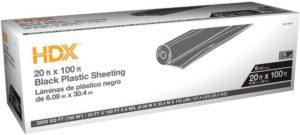
 Large rolls of polyethylene sheeting (sometimes called by one popular brand name, “Visqueen”) can be found at most major hardware stores or construction supply outlets, sometimes near paint supplies. It comes in lengths ranging from 20-200ft, and when unrolled it folds out to anywhere from 8 to 20ft wide. Don’t get the tin stuff used for painting drop cloths. We find that 4mil is more than thick enough to trap heat, but 6mil will be sturdier if you plan to leave it up longer.
Large rolls of polyethylene sheeting (sometimes called by one popular brand name, “Visqueen”) can be found at most major hardware stores or construction supply outlets, sometimes near paint supplies. It comes in lengths ranging from 20-200ft, and when unrolled it folds out to anywhere from 8 to 20ft wide. Don’t get the tin stuff used for painting drop cloths. We find that 4mil is more than thick enough to trap heat, but 6mil will be sturdier if you plan to leave it up longer.
Whether you choose to use black or clear is a matter of preference. Black poly wrap will absorb more heat during the day, but clear poly will allow sunlight in for the birds. We use a bit of both, usually black for the top and back, and clear for the front and sides. The most important part is to keep the cages dry, and block cold wind. To prevent wind from blowing the vinyl and letting the warm air out, it should go all the way to the ground. It can be easily fastened to the bottom of the cage legs with zip ties.
If you don’t have a full enclosure for your aviary, you can drape the cages themselves with plastic sheeting. The birds will pick at it and shred it if they can, so make sure to use some kind of standoffs that keeps it out of reach and not directly on the cages. We use wooden blocks cut from 2x4s with hooks attached. They slid onto the cage bars and we staple the plastic directly to them, but they can be easily lifted and moved whenever we need access under the tent.
In Tennessee, the cold season tends to last longer and can sometimes dip to freezing. At the coldest part of the year, we run power outside and add heat lamps or even distribute ceramic heaters around the space. There are also heated perches, and warming panels specifically made for birds. Even when the air temperatures aren’t below freezing, water bowls, especially metal ones, can still ice up. If you notice that being a problem, you can try a bird bath de-icer or heated water bowl. Just make sure power cords aren’t accessible for chewing and that bowls are rugged enough for beaks!
Power
When using lamps or heaters, it’s VERY important to take care that electrical connections are kept dry. The last thing you want is to trip a breaker, or worse, have a short. Your birds could end up going all night without heat and you wouldn’t necessarily know it. Make sure to check the amount of power draw, you may need to split your heaters up between different circuits.
To keep dangerous moisture out, you can use rubber seals, special enclosure boxes, weatherproof outlets, or even rig up your own DIY solution with rubber gloves and zip ties. You can also get covered outlets with stakes and built in timers or remote controls. These kinds of supplies are super easy to find for cheap during the holiday season, usually next to the Christmas lights. Just make sure the ones you pick are rated to handle the load you plan to put on them. It’s best if the outlets and extension cords you use are grounded (three prong).
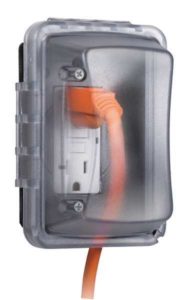
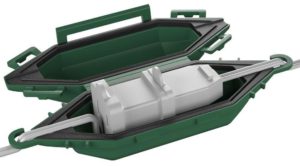
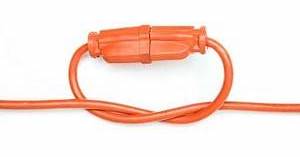
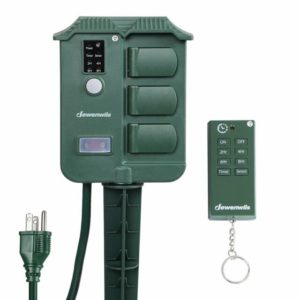
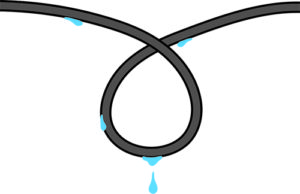 Since covered cages are already protected from direct rain, any cabling underneath should have a good chance of staying dry. The thing to watch for is anywhere water might drip from the roof or the sides and travel along the length of the cord. Suspend cords from cages (out of reach of the birds!) to keep them off the ground and any water and mud that might pool there. It’s also a good practice to add a “drip loop” so that water will collect at the lowest point of the cord instead of near the plug. Any sag in a cord should be in the middle, don’t let connections hang down as the lowest point. When connecting multiple extension cords, it’s best to secure them from being pulled apart if they get snagged or tripped on. A bit of clothes line cord can work as a simple strain relief, or simply tying the cords in a single knot before connecting them.
Since covered cages are already protected from direct rain, any cabling underneath should have a good chance of staying dry. The thing to watch for is anywhere water might drip from the roof or the sides and travel along the length of the cord. Suspend cords from cages (out of reach of the birds!) to keep them off the ground and any water and mud that might pool there. It’s also a good practice to add a “drip loop” so that water will collect at the lowest point of the cord instead of near the plug. Any sag in a cord should be in the middle, don’t let connections hang down as the lowest point. When connecting multiple extension cords, it’s best to secure them from being pulled apart if they get snagged or tripped on. A bit of clothes line cord can work as a simple strain relief, or simply tying the cords in a single knot before connecting them.
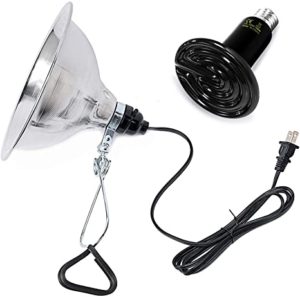
Rather than standard heat lamps, we like ceramic infrared lamps that don’t put off visible light. This keeps from disrupting the normal day/night sleep cycle for the birds and doesn’t annoy the neighbors with a constant glow coming from our property all night long. They’re also more durable than regular bulbs and not as susceptible to shattering if there are extreme temperature changes. The fragile glass of a regular heat lamp can shatter if the hot bulb is suddenly exposed to cold water. If you do use invisible heat sources, you should also have a small visible light plugged in at the end of your wiring so you can easily glance outside and make sure everything is still on. You don’t want to trip a breaker and not realize it!
Make sure to use ceramic sockets for your lamp fixtures. The cheap bulb holders with thin aluminum reflectors and spring clamps usually have a plastic socket and aren’t designed to handle the temperatures that a heat lamp will reach.
Monitoring
You should also keep a digital thermometer to go with your heat lamps underneath the sheeting. You don’t just want to know the outside temperature, you want to know to monitor the actual temperatures your birds are experiencing inside their greenhouse. There are a number of good options that can even relay the readings to a display indoors so you can check without needing to go outside in your pajamas.
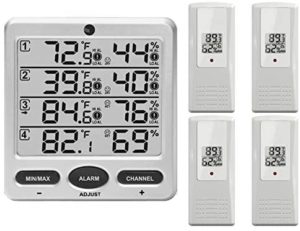 Here is a basic inexpensive model that can receive readings from up to 3 different sensors (sold separately) placed around different locations in your aviary. This one has more features and is still very affordable. This set includes 3 sensors and has the ability to show the temperatures of all 3 sensors at once. This 4-sensor set can receive readings from up to 8 sensors and each sensor has a small digital readout built in. All of these have a range of about 100-200ft and also report humidity.
Here is a basic inexpensive model that can receive readings from up to 3 different sensors (sold separately) placed around different locations in your aviary. This one has more features and is still very affordable. This set includes 3 sensors and has the ability to show the temperatures of all 3 sensors at once. This 4-sensor set can receive readings from up to 8 sensors and each sensor has a small digital readout built in. All of these have a range of about 100-200ft and also report humidity.
If you want to get really fancy, this small bluetooth sensor works with your phone and can send notifications and alerts. It also shows attractive graphs through the mobile app and records the temperature history that you can download to a spreadsheet. This one has similar features but also includes a wifi gateway repeater to extend the distance of the signal by over 250ft. This thermometer comes with an external sensor that can be placed in water if you have a pond or want to monitor monitor dishes. Just don’t put the sensor in a bowl your birds have access to! If you need readings on a large or remote property, this cellular enabled monitor can transmit data using LTE/4G for only $5 a month. It can report vibrations and earthquakes, power losses, light levels, and more. It has a mobile app and can be accessed through your desktop web browser as well.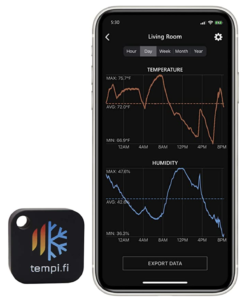 .
. 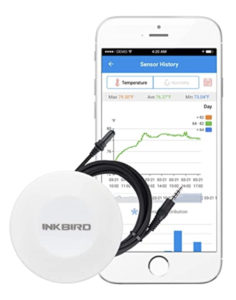
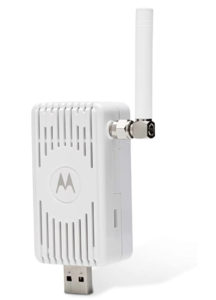
Conclusion
In addition to external temperature adjustments, what you feed your birds can be another factor that helps them adjust to the seasons. When it’s hot, lots of fruits and vegetables help keep birds hydrated and cool. In the colder months, more fat is needed. We tend to use a higher ratio of pellets in the summer, and provide more seed and nut mixes during the winter. But discussions on diet would be another page all together.
As long as you stay aware of the temperatures and other weather conditions, you can easily keep birds inside and outside, no matter what your climate or where you live. Just take common-sense measures to address their needs and keep their comfort and health in mind as much as you would your own.
